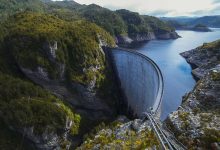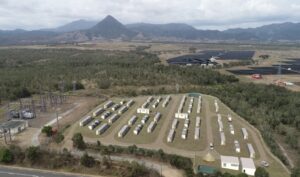A plan to establish Tasmania as the ‘battery to the nation’ using a new undersea cable could be rendered obsolete by the emergence of cheaper big battery projects, new analysis has suggested.
The updated analysis, published by the Victoria Energy Policy Centre and authored by energy market expert Dr Bruce Mountain, suggests it would be cheaper to construct big battery storage projects on mainland Australia, particularly in Victoria, than trying to store and send the power from Tasmania.
Mountain compared the cost of constructing a 1,500MW big battery, with up to four hours of storage capacity, against the Marinus Link proposal, finding that the battery could provide the backup supply of power at more than 20 per cent cheaper.
The Marinus Link project proposes to establish an additional 1,500MW undersea power link between Tasmania and mainland Australia.
The Tasmanian government hopes to use the link, and the state’s supplies of stored hydro energy storage, to see Tasmania serve as an effective battery for Victoria and the broader electricity market.
The undersea link is anticipated to cost around $3.5 billion to construct, with a similar amount of expenditure being considered to boost Tasmania’s hydroelectric storage capacity.
With the total costs expected to exceed $7 billion, Mountain’s analysis suggests it could be cheaper to achieve the same result by installing a suitably large ‘big battery’ in Victoria.
While economic analysis published by TasNetworks, as the lead proponents of the Marinus Link project, suggests that the undersea cable would remain profitable, the research produced by Dr Mountain raises fresh questions about whether it is the best option.
TasNetworks concluded that the construction of a higher capacity undersea link, having considered options of less than 1,500MW in capacity, would provide the greatest financial return, saying that it would deliver significant economic benefits to Tasmania through increased energy exports and supporting the further development of new renewable energy projects.
TasNetwork’s general manager for the Marinus Link project, Bess Clark, said falling battery costs had already been factored into the project’s business case, with the undersea link still standing up financially.
“While batteries are important for short-term ‘day shifting’ of energy – for example, storing excess solar energy throughout the day for use at night time – conventional hydro and long duration pumped hydro offer both day-shifting and longer-term seasonal-shifting of energy, for example, storing excess energy for longer periods of wind and solar droughts,” Clark said.
“The current modelling for Marinus Link already assumes that battery costs will reduce by up to 70 per cent in the next ten years, based on CSIRO projections. Even with this projected cost reduction, the case for Marinus Link is clear.”
Dr Mountain said his updated analysis, responding to a number of claims made by TasNetworks, continued to show that power supplied via the Marinus Link would struggle to compete with battery storage projects located within Victoria, challenging the assessments of the Tasmanian government-owned utilities which continue to push ahead with the project.
“Our initial report released last year focussed mainly on the economics of Marinus Link and this update confirms that Marinus Link continues to have no prospect of competing against battery alternatives in Victoria,” Dr Mountain said.
Dr Mountain pointed to the big battery projects already under development in Victoria – including the 300 MW/450 MWh Victoria Big Battery project and EnergyAustralia’s proposed 300MW/1400MWh big battery at Jeeralang – suggesting that the rapid emergence of viable battery storage projects could ultimately make the Marinus Link unviable by the time it is operational.
“In the year that has passed since our report, the official projections of battery costs have come down, Marinus’ cost has gone up and pumped hydro cost estimates have gone up,” Dr Mountain said.
“We now feel able to conclude that if Hydro Tasmania develops pumped hydro capacity in Tasmania it is very likely that, like Snowy 2.0, it will not be economically viable.”
“Considering the now well-established trend of transmission, pumped hydro and battery costs and the evidence of investor response in the development of batteries, we suggest that the gap between Project Marinus and its competitors will continue to widen in future,” the report adds.
The updated analysis was published by the Bob Brown Foundation on Wednesday, with the group raising additional concerns about the potential ecological impacts of expanded hydroelectric storage developments in Tasmania, including its potential effects on threatened species.
The Bob Brown Foundation’s Christine Milne said the Marinus Link project could end up becoming a financial burden for both Tasmanians and Australians more broadly if it becomes reliant on government finance, suggesting that it had missed its window of opportunity.
“No matter how hard Premier Gutwein tries to spin Project Marinus, it is uneconomic and will be a huge burden on taxpayers and will drive up energy prices if Tasmania persuades Prime Minister to come up with the $3.5 billion as part of the federal election campaign,” Milne said.
“There is such a thing as being too late. It is time for the Tasmanian Government to frame a futuristic vision for Tasmania using our renewable energy for the benefit of Tasmanians and stop chasing expensive duds like Project Marinus.”
TasNetwork’s Clark said that the Marinus Link project was not in competition with battery technologies.
“In fact, our modelling forecasts that over 75 per cent of new storage deployed is battery technology. We will need a portfolio of varying duration storage technologies. They are all part of a broader approach required to deliver a reliable, secure and affordable energy power system,” Clark added.
Lies, myths and greenwashing. Good independent journalism is time-consuming and costly. But small independent media sites like RenewEconomy have been excluded from the tens of millions of dollars being handed out to big media companies from the social media giants. To enable us to continue to hold government and business to account, to cut through the lies and the misinformation about the renewable transition, and to help expand our work, you can make a voluntary donation here to help ensure we can continue to offer the service free of charge and to as wide an audience as possible. Thank you for your support.








